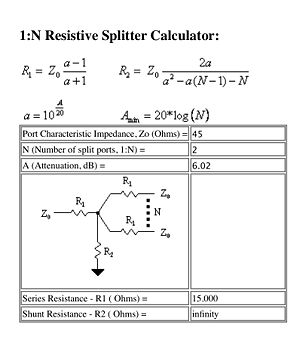Difference between revisions of "Receiver Performance Tests"
From HPSDRwiki
(→Instruments required: added SSB Phase noise measurement) |
(→SSB Phase Noise: complete the example) |
||
| Line 30: | Line 30: | ||
==== SSB Phase Noise ==== | ==== SSB Phase Noise ==== | ||
| − | #Record the signal level of the MDS as A0, then tune away from the signal until you can't distinguish a tone in the noise. At this frequency, increase the amplitude of the signal until the displayed amplitude is the same as A0, note the frequency f1, and then go back to f0 and measure the amplitude A1. | + | #Record the signal level of the MDS as A0, then tune away from the signal until you can't distinguish a tone in the noise. At this frequency, increase the amplitude of the signal until the displayed amplitude is the same as A0, note the frequency f1, and then go back to f0 and measure the amplitude A1. |
| + | #L(f1)=(A0-A1)(10LOG(BW noise). My HPSDR Rig measured A0 at -140 dBm, A1 at -103 dBm and BWnoise =44 Hz at 4.0MHz, so L(at 4.0 MHz with the Pre-amp on) = -37x10 Log(44)=-370x1.643=-608.07dBc/Hz. | ||
==== Dynamic Range ==== | ==== Dynamic Range ==== | ||
Revision as of 20:49, 23 October 2009
Contents
Instruments required
- Two (2) Signal generators
- Hybird combiner
- Audio AC voltmeter
- Distortion meter (FM Only)
- Noise figure meter (for noise figure measurements only)
- Two (2) step attenuators with 10dB and 1dB steps
The signal generators at the W9KFB lab are as follows:
- HP 3586B Selective Level Meter (dBm measurements are calibrated for 75 Ohm characteristic impedance, signal is 0 dBm out only at the level measurement frequency)
- HP 8656B Signal Generator 0.1-990 MHz (dBm measurements are calibrated for 50 Ohm characteristic impedance)
The Hybird combiner was made from an old PC network splitter. The device was found in an used PC warehouse. It was a four port device with 4 BNC jacks on it. On inspection of the device, we found that it was a resistive splitter with four 39 Ohm resistors connected to each BNC center contact and a common point. These were removed and replaced with 15 Ohm 2 Watt 2% resistors metal film resistors (NTE 2W015 Flameproof Resistors).
To design you own splitter/combiner see this web site for a calculator[1]
Sensitivity
The Sensitivity test is very simple to do on an HPSDR rig:
- Calibrate the level and frequency on the rig with the output of the signal generator using PowerSDR's Setup calibration at the test frequency using a -40 dBm signal.
- Set the AGC to "Fixed" and set the AGC-T to a set value to hear the demodulated tone ("78" works). Set the panadapter to average the signals.
- Set the Mode to CWL and the bandwith to 25.
- Reduce the signal to where the signal disappears into the noise. Then raise the signal up until the peak, still in the pass band, is 3 dB above the noise floor. This value will be the minimum discernible signal (MDS).
- Obtain a MDS value with the preamp on and off at the same test frequency by repeating all the above steps.
SSB Phase Noise
- Record the signal level of the MDS as A0, then tune away from the signal until you can't distinguish a tone in the noise. At this frequency, increase the amplitude of the signal until the displayed amplitude is the same as A0, note the frequency f1, and then go back to f0 and measure the amplitude A1.
- L(f1)=(A0-A1)(10LOG(BW noise). My HPSDR Rig measured A0 at -140 dBm, A1 at -103 dBm and BWnoise =44 Hz at 4.0MHz, so L(at 4.0 MHz with the Pre-amp on) = -37x10 Log(44)=-370x1.643=-608.07dBc/Hz.



